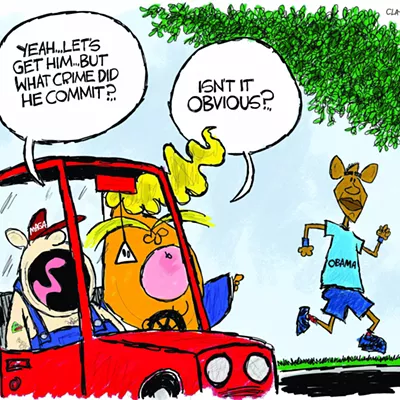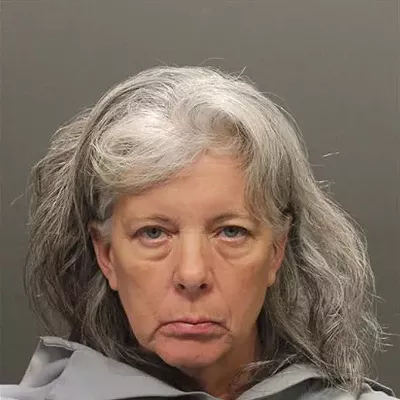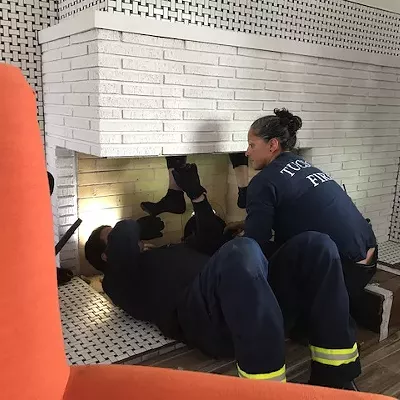He was given no oxygen--something that is administered as routinely as nine out of 10 calls, according to one of the firefighters who responded to the call to evaluate and treat Johnson after Johnson briefly fled from two Tucson policemen on Aug. 8, 1999.
Officers Eric Murch and Floyd Ginn wanted to take Johnson to jail. Murch said Johnson gave his brother's name instead of his own when asked. Ginn said he found a crack pipe on the seat of the Cadillac that Johnson was trying to gas up at the Circle K at East Golf Links and South Craycroft roads.
Johnson was put in a slow-ride, basic life-support ambulance from Southwest Ambulance Co. rather than an advanced life support unit from Tucson Fire Department. Even then, he received no oxygen. Nine minutes into the ride to Kino Community Hospital--just more than five miles away--Johnson, 28, had a heart attack, stopped breathing and died.
A fuller picture of what led up to Johnson's final minutes is emerging in U.S. District Court in Tucson, where Johnson's survivors are pressing a civil rights lawsuit against the city, the police, the fire department, Southwest Ambulance and individual fire fighters, paramedics and EMTs.
Johnson, a two-way football star at Pueblo High School before one of his knees was ruined in a freak injury, ran from Murch in the Circle K parking lot and struggled to get over a 5-foot wall by hopping onto an abutting, 2-foot retaining wall.
He led Murch through the backyard of Robert Hernandez's house, through the carport and to the driveway. During the chase--and after the severely winded Johnson stopped on the hot pavement in front of Hernandez's house--Murch and Ginn struck him with metal batons up to 11 times. Murch sprayed Johnson three times with pepper spray, including one full shot square in the face.
Hernandez, a soft-spoken nursery worker and groundskeeper, said he was on his roof shortly after 10:30 a.m. that morning to repair his cooler. From that vantage point, he saw much of the chase, and watched as Murch tried repeatedly to get Johnson to lie prone on the hot pavement. Johnson, about 6 foot 2, and 250 pounds, would not, or could not, even when Murch, Hernandez said, climbed on Johnson's back.
Hernandez, while responding to questions from the Johnson family's lawyer, Stanton Bloom, said Tyrone Johnson could not have fled further.
"He pulled up," Hernandez said. "He just pulled up. It was over."
Johnson, Hernandez said, was "spent."
Contradicting Murch's earlier testimony that Johnson did more than run, Hernandez said a chain link gate on his property cannot swing back beyond its closed position. Murch previously claimed that Johnson swung the gate back forcefully to hit him.
According to Hernandez's testimony, Murch repeatedly hit Johnson.
"He wouldn't flatten out, so the officer hit him again," said Hernandez, who indicated where Johnson w as hit by pointing to an area between his shoulders, near the neck.
By the time Ginn arrived to cuff Johnson (Murch had already used his pair to handcuff a man who had come to help Johnson with a leaking fuel tank on the Cadillac), Johnson was "laboring" to breathe, Hernandez said. Murch yelled to Hernandez to dial 911, which Hernandez did, also bringing a plastic cup of water for Johnson.
Hernandez said he thought Johnson "was begging for help." He testified that Johnson said, "I can't breathe; I have asthma," to which Murch replied, "Yeah, I know about your asthma."
Across a small alley from the Hernandez home, that Aug. 8 morning was quiet for Ramon Garcia, his wife, Edna, and their daughter Vanessa, until the commotion at the end of the chase.
Vanessa, then 14, told the 10-member jury last Friday that she saw Johnson stick his head out of the window of the police car he'd been put into and then heard him say, repeatedly, "I can't breathe. I can't breathe."
Tucson Fire Department paramedics placed Johnson on his knees and leaned him over a short brick retaining wall in Garcia's yard while they rinsed his face with water from Garcias' garden hose. In testimony in the last two weeks, firefighters acknowledged that water can exacerbate the burning and inflammation caused by pepper spray.
Johnson, Vanessa Garcia testified, was an "ashy" color.
The three lawyers who are tag-teaming Bloom won approval by Judge John M. Roll to severely limit the testimony of James McLaughlin, the former head of emergency medicine at Kino and the doctor who tried to revive Johnson. Roll permitted Bloom to ask McLaughlin, who now works for Carondelet, only about what he saw when Johnson was brought into the hospital, and what treatment and drugs were given. Bloom, for example, was not allowed to ask McLaughlin about what was known of Johnson's condition, and whether--had he been fully informed of it--McLaughlin would have asked for an advance life support ambulance.
With Bloom nearly silenced by Roll, Southwest Ambulance turned to its A-team lawyer--Foster Robberson, of Lewis & Roca's Phoenix office--to handle McLaughlin, rather than Brendan Griffin, of the firm's Tucson office.
Robberson, an unsuccessful candidate for the Republican nomination for state attorney general two years ago, wasted no time in demonizing Johnson.
"You've seen cardiac arrest from cocaine use?" he asked McLaughlin, who paused, then cautiously said, "Yes."
Robberson, experienced in medical cases, proceeded with numerous questions aimed at portraying Johnson as a drug abuser who caused his own death. He quizzed McLaughlin about supposed "track marks" on Johnson's arms and the supposed difficulty that emergency room personnel had in finding a suitable a suitable vein for intravenous medication.
"Is that," Robberson asked, "typical for someone who is a drug addict?" (Toxicology studies revealed cocaine and opiates in Johnson's system.)
While Bloom was not allowed to probe McLaughlin about Johnson's medical condition or whether he would have been treated and transported differently had the doctor known all the facts, Robberson was free to use McLaughlin's appearance to raise suspicion about Johnson.
Keeping with his drug-culture theme, Robberson used his time with McLaughlin to have the jury hear that Kino staff found $1,000 in Johnson's wallet.
Timothy Johnson said outside court that the money had come from their father, the late Frank Johnson, not from any drug business.
"This case," Timothy Johnson said last week, "is not just about Tyrone or just about African Americans and the police. This could happen to anyone."
The trial is sad reminder for more than the Johnson family.
Saturnino "Curly" Santa Cruz was the football coach at Pueblo High, where Tyrone Johnson played varsity as a sophomore and starred as a tight end and defensive end in his junior year.
"He was like a 15-year-old kid who was going on 30," Santa Cruz said in an interview. "He was already grown up. The big schools like UCLA wanted him. And the injury was a freak thing--a small kid hit his leg in the wrong spot during a blocking drill. It was just a freak thing. I felt so sorry when I heard he died. I loved Tyrone."










